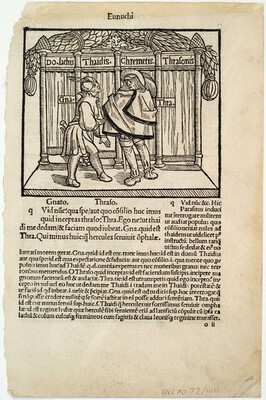B.
A page from Eunuchi by Badius and Trechsel
Collection
This article first appeared as 'From scrap to centre stage' in The Press on 8 September 2015.
In 1972 artist, curator and commentator Gordon Brown donated some 40 works to the Robert McDougall Art Gallery, mostly British and European prints. The illustrated leaf of paper shown here was among them and it remained uninterpreted - a scrap of paper that was very little understood. However over the last couple of years this scrap has been the subject of academic attention: it has been accurately identified, transcribed, translated, dated and finally this year, it has appeared on the cover of a book.
It may look very much like a manuscript and that is part of its story, since, if we count Guthenberg's 42 line Bible in the 1450s as the birth of printing in Europe, the craft was only 40 years old when this page was created in 1493. Design did not change overnight and manuscripts of this work do indeed look very similar to this printed version. Items printed before 1500 are conventionally known as incanabula (from the Latin for cradle) and although nothing happened on 1 January 1501 that sets later work apart, it is a convenient way of identifying the very earliest examples of printing. And our page is unquestionably one such example. It was printed and published in Lyon in 1493 and is part of the complete works of Roman playwright Terence.
Dr Andrew Turner of the University of Melbourne has said: 'Terence's six plays were a staple of the mediaeval Latin curriculum; a number of manuscripts containing illustrations to each of the scenes exists. The Lyon edition is exceptionally important in that it is the earliest full printed edition of Terence to contain these illustrations.'
This page comes from 'The Eunuchs' which is a farce, with misunderstandings and people coming in out of doors - four of them in our woodcut illustration, each conveniently labelled with its owner's name. 'Do.' above the first means 'domus' or house, followed by the name of the character whose house it is. The two speakers, Gnatho and Thraso, their names abbreviated, are also labelled. The block of text to the left in the larger font represents the words being spoken, the rest of the text, in the smaller font, is analysis and scholarship from previous editions. Dr Turner again: 'The layout of this page reflects almost exactly that of contemporary manuscripts, which frequently had a small block of text surrounded by extensive commentary in the margins.'
It is known that the plays of Terence were being performed in Italy in the late fifteenth century - the first time since the fall of the Roman Empire - and whether the illustrations we see here show Renaissance performance practice is the subject of academic debate. This debate is happening between academics in journal articles and conference papers, culminating in the book on which our little page takes centre stage on the cover: 'Terence between late antiquity and the age of printing', by Andrew Turner and Giulia Torello-Hill. This book analyses the ways the texts of Terence's plays were hand-written (and later printed), the way they were illustrated and what this might in turn tell us about how they were performed. Gordon Brown's gift sits squarely and magnificently in the middle of this debate.
Another copy of the Lyon edition of Terence's plays - and yes this is printing so there are of course multiple copies - can be seen on the website of the French National Library. The continuing assistance of Andrew Turner in helping to interpret and understand this work is sincerely appreciated. Any errors in this article are mine alone.

